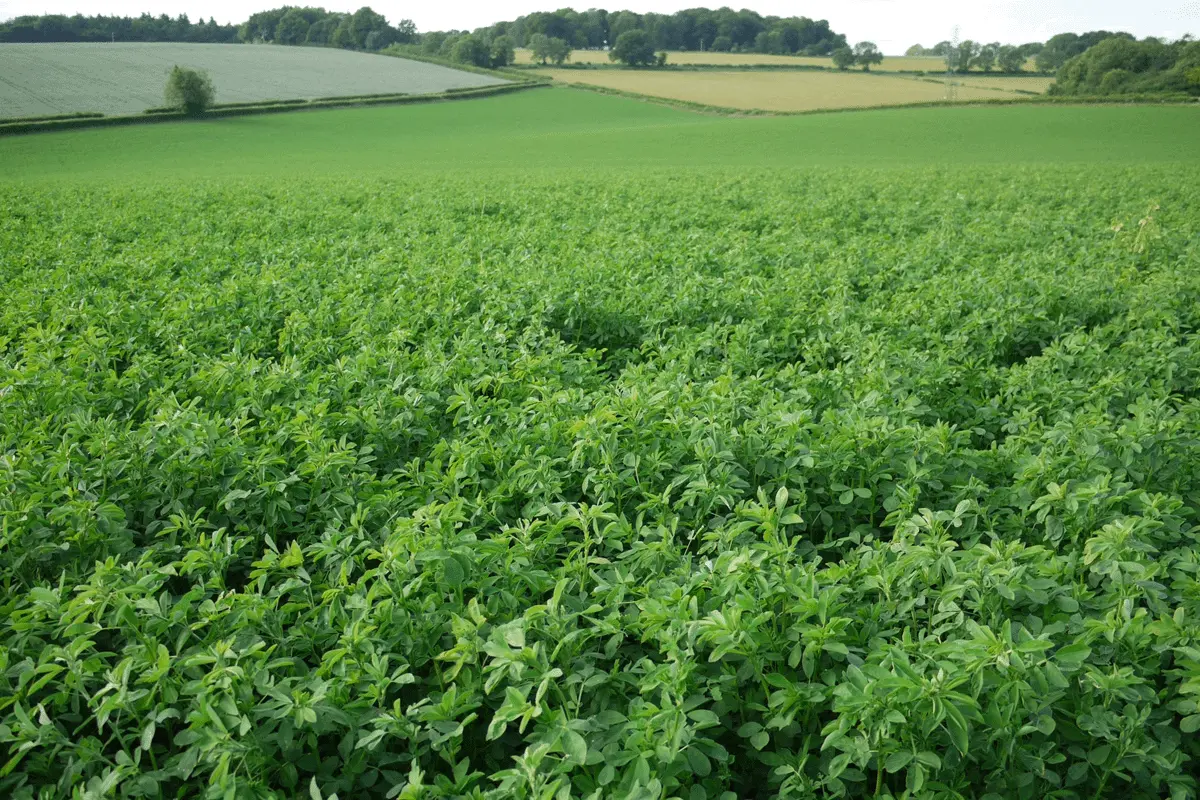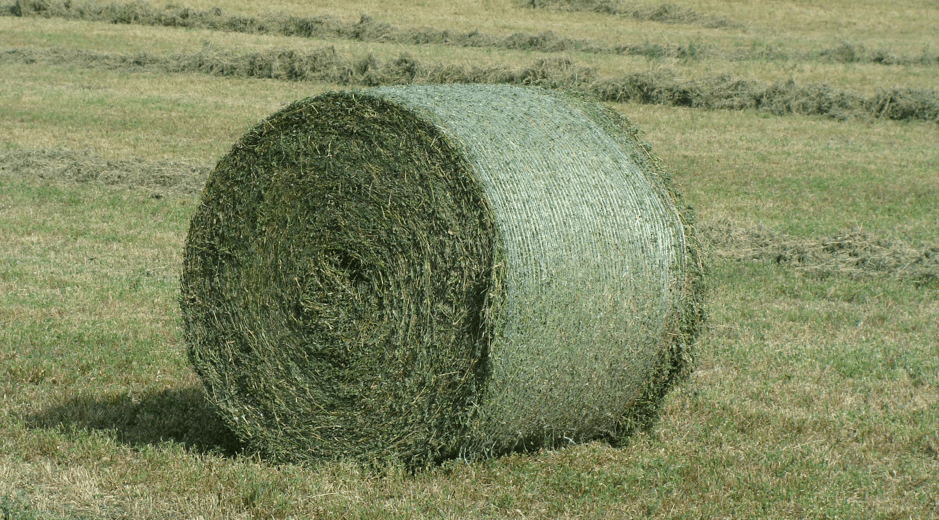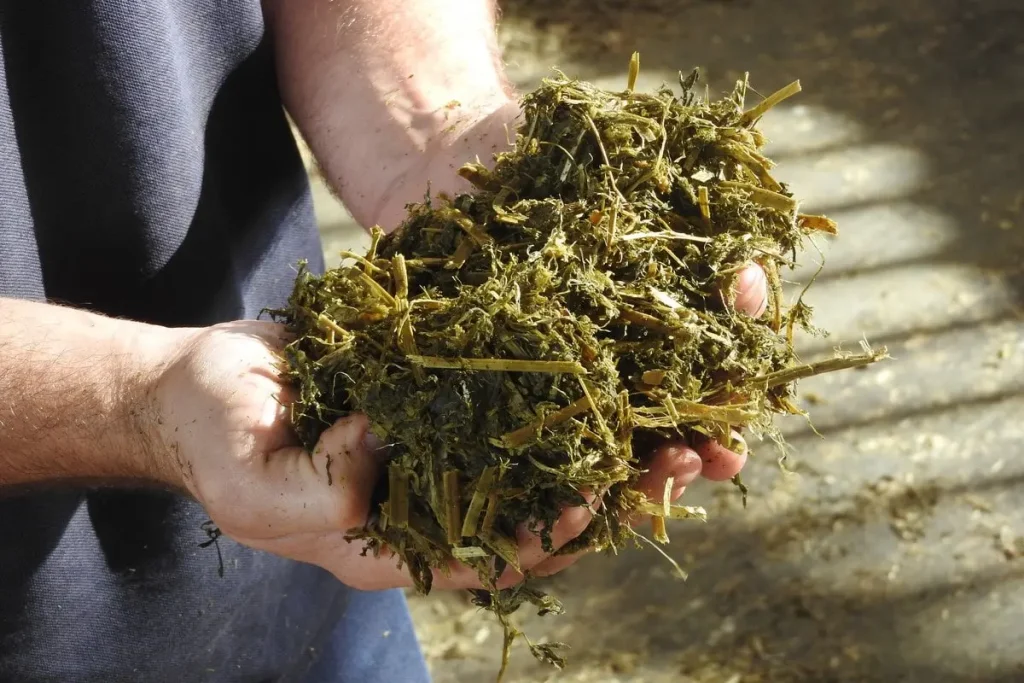Interest among UK livestock farmers in sowing lucerne seed has increased significantly in recent years. Once established, lucerne crops have the potential to provide an affordable source of homegrown protein while reducing reliance on bought-in fertiliser by up to 300 kg N/ha. But these are just some of the reasons why farmers are sowing lucerne seed.
What is lucerne?
Also known as alfalfa (Medicago sativa), lucerne is a legume that grows with deep roots and returns perennially. Lucerne crops can be grown in the UK by farmers who are seeking a nutritious, soil-enriching source of forage for their livestock.
Contents
- Lucerne crops can fix nitrogen
- Site selection for sowing lucerne seed
- Lucerne crop management
- Cutting, feeding and grazing lucerne
- Yields and feed quality
- Variety selection
Lucerne crops fix nitrogen in soil
As a nitrogen-fixing legume, lucerne is commonly compared with white and red clover, and its similarities with the latter extend also to its ability to thrive in dry conditions due to its deep taproot.
Lucerne seed can be sown to grow a stand-alone crop, primarily for cutting but with some grazing potential. Whether cut or grazed, the forage is highly digestible and typically rich in minerals due to its deep rooting nature.
With the correct management, lucerne crops should persist for four to six years, producing 10-15 tonnes DM/ha at 18-24% crude protein.
Variety choice, as with any cropping option, is critical. For the UK grower, winter hardiness and disease resistance are key characteristics, and recent breeding progress is now increasing the viability of lucerne as a forage crop.

Lucerne versus red and white clover
| Characteristic | Red clover | White clover/grass | Lucerne |
| Soil type | All types | All types | Well-drained |
| Ideal pH | 5.8-7.5 | 5.8-7.0 | 6.2-8.5 |
| Establishment rate | Fast | Medium | Medium |
| Inoculation needed | No | No | Yes |
| Drought tolerance | High | Medium | Very high |
| Persistence | Low | Very high | Medium |
| Regrowth rate | High | High | High |
| Yield | 10-15 t DM/ha | 4-10 t DM/ha | 10-15 t DM/ha |
| Silage quality | ME 9.8-11 MJ/kg/DM CP 16-22% pH 4-4.5 | ME 9.8-12 MJ/kg/DM CP 16-20% pH 3.5-5.5 | ME 9.0-11 MJ/kg/DM CP 18-24% pH 4.3-4.4 |
| Other features | High PPO* | Low PPO | Low PPO |
Sources: Legume Silages for Animal Production, R.J. Wilkins; Legumes for Milk and Meat, R. Shedrick, G. Newman and D.J. Roberts (*Polyphenol oxidase [PPO] is an enzyme that enables animals to utilise protein more efficiently.)
Site selection for sowing lucerne seed
Modern varieties of lucerne selected for their suitability to a northern European climate can be grown successfully on a wide range of fertile free-draining sites and soil types. However, the lucerne crop will not thrive in waterlogged soils, so the general advice is to avoid heavier land that is not free-draining.
For optimum performance and to minimise the threat of pests and diseases, a period of five years should be allowed in the rotation between lucerne crops. Lucerne offers the advantage of leaving significant residual nitrogen for the following crops.
Seedbed preparation
Lucerne seed is slow to establish so it is very important to ensure the correct balance of soil nutrients are in place and that any soil compaction and perennial weed issues are remedied in advance.
Soil nutrient testing should be carried out to assess requirements to achieve a pH in the range 6.2-8.5 and soil indices of at least 2 for both phosphate and potash. The trace elements magnesium, sulphur, molybdenum and boron are particularly important in the establishment phase.
Calcium is essential for nodulation and nitrogen fixation; it is unlikely to be deficient if recommended pH levels are maintained.
How to plant lucerne seeds
Lucerne seed should be sown when soils are warm into a fine and firm seedbed to a depth of 0.5-1 cm. Seed can be drilled (10 cm rows) or broadcast and fields must be rolled well before and after sowing to ensure good soil-to-seed contact and optimum soil moisture retention.
How long does lucerne take to grow?
Spring sowing from late April tends to be more common with lucerne as this ensures strong plants going into the first winter. However, lucerne seed can be sown successfully up to the middle of August in the southern half of England.
Inoculation
Lucerne is supplied by Germinal pre-inoculated to ensure successful root nodulation and efficient nitrogen-fixing.
Sowing with a nurse crop
Nurse crops can be used to assist in the establishment of lucerne, helping to out-compete weeds. Lucerne seed can be undersown with a spring cereal (sown at 50-75% rate) and cut as arable or wholecrop silage.
Lucerne seed rates
| Cropping system | Seed rates | Notes |
| Pure lucerne stand | Lucerne at 900 seeds/m2 (2 Precidose packs/ha) | Maximum protein crop. Target plant population of 200-400 plants/m2 after12 months |
Lucerne undersown with cereal nurse crop | Lucerne at 900 seeds/m2 (1 ha bags of 25 kg) Cereal seed at half rate (100 kg/ha) |
Lucerne crop management
With good establishment and subsequent management, lucerne should persist for four-to-six years. Slurry should not be applied to lucerne in the seeding year as young plants are very vulnerable to mechanical damage.
Spring-sown lucerne crops should produce a light cut by mid-August whilst crops sown in the summer will produce their first cut by the following June. Nitrogen is not required once rhizobial fixation has been established.
Persistency tips for lucerne crops
- Select a variety suited to UK conditions
- Monitor pests and diseases and take prompt action to control
- Fertilise to replace nutrient offtake
- Allow plants to flower once a year; this ensures storage of nutrients in the taproot to improve winter hardiness and boost spring growth
- Allow a minimum of four to five weeks between cuts
- Cut when 10% of flowers are showing (early bud stage)
- Aim for an optimum cutting height of 7 cm and never cut below 5 cm
- Avoid late cuts, particularly in wet years and when early autumn frosts are a threat
- Manage to avoid soil capping and do not allow grazing livestock to poach and damage to the crown
- Do not drive over the crop in wet conditions
Pests and diseases
The choice of agrochemicals to control pests and diseases in lucerne is limited and – unless tramlines are used – opportunities to enter the actively growing crop will be limited. It is, therefore, important to ensure good establishment practice, monitor growing crops closely and seek specialist agronomy advice if crops are challenged.
The use of a cover or nurse crop can increase the incidence of attack from slugs, Sitona weevil pupae, and leatherjackets, particularly when growing conditions are unfavourable and the crop is ‘smothered’.
| Pest/disease | Comments |
| Slugs | Can be a problem at establishment. Monitor and use slug pellets if necessary |
| Sitona weevil larvae and leatherjackets | Can cause damage to shoots in early establishment phase. Consult an agronomist regarding spray control options |
| Eelworm | Infestations of the soil can cause persistency problems More common on heavier soils Choose resistant varieties where a threat is possible Cut infested fields last |
| Aphids | A potential problem in established crops Consult an agronomist if the problem is suspected |
| Verticillium wilt | Leaves wilt on warm days and become blotchy with yellow or brown markings; they eventually die leaving bare green stems Choose resistant varieties as there are no current chemical control options |
Cutting, feeding and grazing lucerne crops
Lucerne has an erect growing habit and is therefore primarily a silage crop because the frequent defoliation and the potential for poaching resulting from grazing are detrimental to crop survival.
Cutting
| Cropping system | Age of crop | Optimum cutting dates |
| Pure lucerne | Spring sown, year of sowing | One cut in mid-August |
| Summer sown, year of sowing | No cutting | |
| Summer sown, following year | Cut first in the spring after the crop is in bud, and then follow regime as below | |
| Second year onwards | Cut at first flower bud stage (April – mid-May) and follow with up to three cuts in a season (4-5 week intervals) Final cut not later than mid-September Allow the crop to flower at least once, to ensure nutrients are stored in the taproot | |
| Lucerne undersown to spring cereal | Year of sowing | Cut when cereal grains are milky |
| Following year | Cut first in the spring after the crop is in bud, and then follow regime as above |
Cutting best practices
- Ideally, use a drum mower and avoid aggressive conditioning and prevent excessive loss of leaf material (70% of protein and 90% of minerals/vitamins are in the leaf)
- Cut to a minimum stubble height of 7 cm to avoid damage to the crown (growing point) and create good airflow under the swath to aid drying
- Cut in the morning just as the dew leaves the crop to maximise drying time
- Turn the crop where it lies but do not spread it
Lucerne silage: Ensiling best practices
- Aim for a target dry matter of 30-40% for clamp silage and 50% for bales
- Chop to 3-4 cm and roll well in the clamp
- For bales, wilt to 40-60% dry matter and ensure at least four layers of plastic to minimise the risk of stems piercing the wrap
- Always use an additive as lucerne is low in sugars.

Lucerne grazing: Best practices
- Stock must be controlled by an electric fence not only to limit access but to prevent back-grazing of regrowth.
- It is a good idea to rotationally graze lambs before ewes so that young animals select the more nutritious growth.
- Graze lucerne rotationally with five-to-six-week intervals.
- Graze priority stock classes first, to maximise their uptake of the leaves (where most of the feed value is contained).
- Only graze lightly in the autumn (after the crop has stopped growing) to minimise damage.
- Manage carefully to minimise the risk of bloat:
- Feed roughage (e.g. hay) before turning onto lucerne.
- Avoid turning animals onto lucerne when hungry.
- Take extra care when crops are particularly lush (spring or autumn) and/or wet with dew.
- Alternate lucerne grazing with grass grazing.
- Use anti-bloat drenches or rumen bullets if necessary.
Yields and feed quality of Lucerne crops
Lucerne is a palatable protein-rich forage, high in fibre, and an ideal supplement in mixed rations. It is good complementary forage to high-energy feedstuffs such as maize.
| Feed criteria | Value | Comments |
| Fresh yield | 35-50 t ha/yr | Yields will persist for 4-6 years with the correct management |
| Dry matter yield | 10-15 t /ha/yr | |
| Dry matter | 30-40% | 50% if ensiled in big bales |
| Crude protein | 18-24% | Good complement for energy-rich rations |
| D-value | 70% | |
| ME | 9-11 MJ/kgDM | |
| Vitamins | A, B, C & E | Rich in vitamins and minerals due to deep taproot |

Variety selection
There are currently two main types of lucerne grown in Europe and it is important for UK growers to understand the difference, and in particular their winter dormancy ratings.
‘Provence’ types are very drought tolerant and have a long growing season, but are not winter hardy in the UK. In comparison, the ‘Flemish’ types are more cold-tolerant, due to their winter dormancy, and will yield well over three or four large silage cuts.
Winter dormancy ratings range from 1 (very dormant in winter) to 12 (virtually no winter dormancy, and the optimum for UK conditions is four-to-five years.
Lucerne seed breeders have been active in recent years in improving the performance potential of varieties, with yield and protein production increasing alongside greater resistance to common problems such as stem nematode.
Germinal is here to provide UK farmers with expert insights into how to grow the most effective forage crops.
Webinar: Growing lucerne crops
Grass and forage crop experts
Ask our experts if you're interested in sowing lucerne crops in your farming system.
